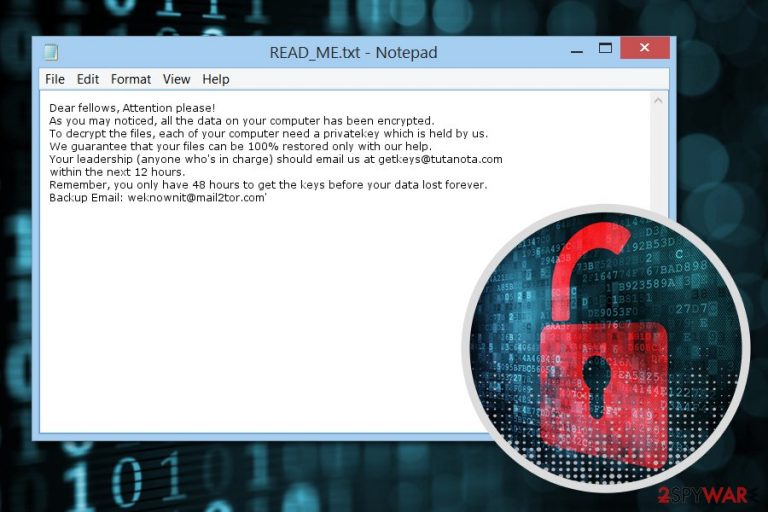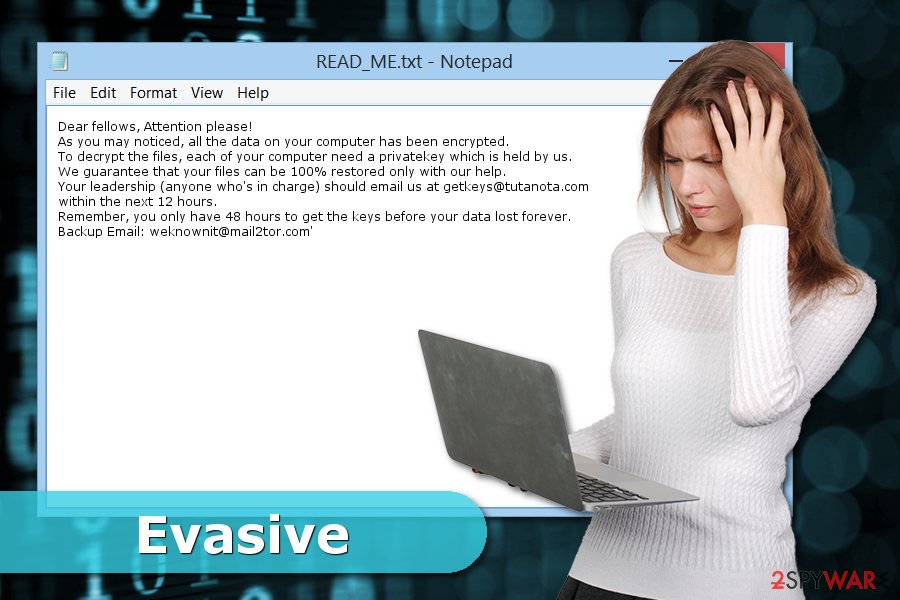Evasive ransomware / virus (Recovery Instructions Included) - Easy Removal Guide
Evasive virus Removal Guide
What is Evasive ransomware virus?
Evasive – another malware based on open source ransomware project

Evasive is a file-encrypting virus that is written based on the HiddenTear[1] code. The virus uses AES cryptography to corrupt data on the targeted computer and appends .locked file extension. Following successful encryption procedure, malware drops a ransom note in READ_ME.txt file where crooks ask to contact them via email.
Evasive ransomware targets the most popular file types in order to cause more damage to the victim and make him or her to pay the ransom. The virus is known to corrupt these types of files:
.aspx, .cpp, .csv, .doc, .docx, .h, .html, .jpg, .jsp, .lnk, .mdb, .odt, .pdf, .php, .png, .ppt, .pptx, .psd, .pst, .rar, .sql, .txt, .xls, .xlsx, .xml, .zip.
In the text file, authors of the Evasive virus tell victims to contact them via getkeys@tutanota.com within 12 hours since the attack. They also give a backup email (weknownit@mail2tor.com) if something goes wrong with the primary one. Additionally, criminals warn that the decryption key is available only for 48 hours.
However, it might be just a psychological terror and attempts to scare the victim into paying the ransom. Security experts from SemVirus.pt[2] suggest staying calm and do not rush into following hackers’ demands. They will ask to pay some Bitcoins, but they may never give you a working decryption software. Thus, it’s better to remove Evasive and try alternative recovery methods.
The malicious program makes numerous changes to the system. For this reason, it’s not recommended to eliminate crypto-virus manually. You should opt for the automatic Evasive removal method which requires scanning the system with FortectIntego or similar malware removal tools.
However, if ransomware prevents you from installing or using security software, reboot to Safe Mode with Networking or try System Restore methods (explanation below) to disable Evasive and run its automatic elimination.

Distribution techniques of the crypto-malware
The virus is most likely to enter the system when a user opens a malicious email attachment. Malware payload might be presented as a safe looking Word, PDF or another file. However, you should always look up for the signs of phishing email[3] instead of rushing to open the attachment.
Additionally, Evasive might infiltrate with the help of:
- malicious ads;
- bogus downloads;
- fake updates;
- exploit kits.
Keep in mind that even the strongest antivirus cannot protect you fully from the cyber attack. You have to watch your clicks and downloads in order not to be misled by dangerous content.
The correct way to eliminate Evasive from the computer
We want to stress out that only powerful security programs can safely and effectively remove Evasive from the computer. The malicious program is capable of injecting malicious code into legit system processes and install numerous harmful components that are hard to detect manually.
Only experienced IT specialists can wipe out malware from the device without causing the damage. However, home computer users do not need to bring their laptops or PCs to the nearest specialist. It’s enough to install reputable malware removal tool and get rid of the virus with it.
We recommend FortectIntego, SpyHunter 5Combo Cleaner or Malwarebytes for Evasive removal. Of course, you can choose your preferred tool as well. However, if you have problems with its installation or system scan, check the guide below.
Getting rid of Evasive virus. Follow these steps
Manual removal using Safe Mode
Rebooting to Safe Mode with Networking helps to disable the virus and run automatic its elimination.
Important! →
Manual removal guide might be too complicated for regular computer users. It requires advanced IT knowledge to be performed correctly (if vital system files are removed or damaged, it might result in full Windows compromise), and it also might take hours to complete. Therefore, we highly advise using the automatic method provided above instead.
Step 1. Access Safe Mode with Networking
Manual malware removal should be best performed in the Safe Mode environment.
Windows 7 / Vista / XP
- Click Start > Shutdown > Restart > OK.
- When your computer becomes active, start pressing F8 button (if that does not work, try F2, F12, Del, etc. – it all depends on your motherboard model) multiple times until you see the Advanced Boot Options window.
- Select Safe Mode with Networking from the list.

Windows 10 / Windows 8
- Right-click on Start button and select Settings.

- Scroll down to pick Update & Security.

- On the left side of the window, pick Recovery.
- Now scroll down to find Advanced Startup section.
- Click Restart now.

- Select Troubleshoot.

- Go to Advanced options.

- Select Startup Settings.

- Press Restart.
- Now press 5 or click 5) Enable Safe Mode with Networking.

Step 2. Shut down suspicious processes
Windows Task Manager is a useful tool that shows all the processes running in the background. If malware is running a process, you need to shut it down:
- Press Ctrl + Shift + Esc on your keyboard to open Windows Task Manager.
- Click on More details.

- Scroll down to Background processes section, and look for anything suspicious.
- Right-click and select Open file location.

- Go back to the process, right-click and pick End Task.

- Delete the contents of the malicious folder.
Step 3. Check program Startup
- Press Ctrl + Shift + Esc on your keyboard to open Windows Task Manager.
- Go to Startup tab.
- Right-click on the suspicious program and pick Disable.

Step 4. Delete virus files
Malware-related files can be found in various places within your computer. Here are instructions that could help you find them:
- Type in Disk Cleanup in Windows search and press Enter.

- Select the drive you want to clean (C: is your main drive by default and is likely to be the one that has malicious files in).
- Scroll through the Files to delete list and select the following:
Temporary Internet Files
Downloads
Recycle Bin
Temporary files - Pick Clean up system files.

- You can also look for other malicious files hidden in the following folders (type these entries in Windows Search and press Enter):
%AppData%
%LocalAppData%
%ProgramData%
%WinDir%
After you are finished, reboot the PC in normal mode.
Remove Evasive using System Restore
Rebooting to Safe Mode with Command Prompt and enabling System Restore is another way to run automatic Evasive ransomware removal.
-
Step 1: Reboot your computer to Safe Mode with Command Prompt
Windows 7 / Vista / XP- Click Start → Shutdown → Restart → OK.
- When your computer becomes active, start pressing F8 multiple times until you see the Advanced Boot Options window.
-
Select Command Prompt from the list

Windows 10 / Windows 8- Press the Power button at the Windows login screen. Now press and hold Shift, which is on your keyboard, and click Restart..
- Now select Troubleshoot → Advanced options → Startup Settings and finally press Restart.
-
Once your computer becomes active, select Enable Safe Mode with Command Prompt in Startup Settings window.

-
Step 2: Restore your system files and settings
-
Once the Command Prompt window shows up, enter cd restore and click Enter.

-
Now type rstrui.exe and press Enter again..

-
When a new window shows up, click Next and select your restore point that is prior the infiltration of Evasive. After doing that, click Next.


-
Now click Yes to start system restore.

-
Once the Command Prompt window shows up, enter cd restore and click Enter.
Bonus: Recover your data
Guide which is presented above is supposed to help you remove Evasive from your computer. To recover your encrypted files, we recommend using a detailed guide prepared by 2-spyware.com security experts.If your files are encrypted by Evasive, you can use several methods to restore them:
Try Data Recovery Pro after ransomware attack
It's not an official Evasive decryptor. However, it might help to recover at least some of the files with .locked extension.
- Download Data Recovery Pro;
- Follow the steps of Data Recovery Setup and install the program on your computer;
- Launch it and scan your computer for files encrypted by Evasive ransomware;
- Restore them.
Try Windows Previous Versions feature
If System Restore was enabled before the ransomware attack, follow these steps to copy individual files:
- Find an encrypted file you need to restore and right-click on it;
- Select “Properties” and go to “Previous versions” tab;
- Here, check each of available copies of the file in “Folder versions”. You should select the version you want to recover and click “Restore”.
Try ShadowExplorer
If ransomware is left Shadow Volume Copies untouched, you can restore some of the missing data with ShadowExplorer.
- Download Shadow Explorer (http://shadowexplorer.com/);
- Follow a Shadow Explorer Setup Wizard and install this application on your computer;
- Launch the program and go through the drop down menu on the top left corner to select the disk of your encrypted data. Check what folders are there;
- Right-click on the folder you want to restore and select “Export”. You can also select where you want it to be stored.
Evasive ransomware decryptor is not available yet
However, instead of paying the ransom, you should try HiddenTear decryptors as well:
Finally, you should always think about the protection of crypto-ransomwares. In order to protect your computer from Evasive and other ransomwares, use a reputable anti-spyware, such as FortectIntego, SpyHunter 5Combo Cleaner or Malwarebytes
How to prevent from getting ransomware
Stream videos without limitations, no matter where you are
There are multiple parties that could find out almost anything about you by checking your online activity. While this is highly unlikely, advertisers and tech companies are constantly tracking you online. The first step to privacy should be a secure browser that focuses on tracker reduction to a minimum.
Even if you employ a secure browser, you will not be able to access websites that are restricted due to local government laws or other reasons. In other words, you may not be able to stream Disney+ or US-based Netflix in some countries. To bypass these restrictions, you can employ a powerful Private Internet Access VPN, which provides dedicated servers for torrenting and streaming, not slowing you down in the process.
Data backups are important – recover your lost files
Ransomware is one of the biggest threats to personal data. Once it is executed on a machine, it launches a sophisticated encryption algorithm that locks all your files, although it does not destroy them. The most common misconception is that anti-malware software can return files to their previous states. This is not true, however, and data remains locked after the malicious payload is deleted.
While regular data backups are the only secure method to recover your files after a ransomware attack, tools such as Data Recovery Pro can also be effective and restore at least some of your lost data.
- ^ Meleah Maynard. How the Hidden Tears Project Aims to Stop Abuse Before It Happens. Studio Daily. News and entertainment website.
- ^ SemVirus. SemVirus. Latest cyber security news.
- ^ Brien Posey. 10 tips for spotting a phishing email. TechRepublic: News, tips, and advice for technology professionals.







